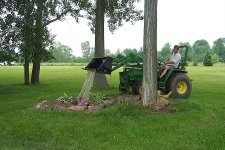That's a funny thought process that I see a bit of around here...why would adding a ballast box remove any of the stress of using a front end loader from your front axle? As I see it, having one would ADD to that stress. Follow me for a moment. You have a tractor with limited or no ballast on the rear, you pickup something heavy on the front, it lifts the rear a little, then you have less traction, so you remember to not lift so much the next time...OR you add a ballast box, now you can lift more and not realize the impact on the tractor's traction. What you are doing is holding the rear down...somewhere there's a fulcrum...you hear of people w/ cracked transmissions and bell housings? Ever wonder why? They're only built to hold up so much, if you add capacity by adding a counter weight, expect something to give in between. Just the thoughts of an amused observer...
Read the tractor's manual about ballasting your machine.
Tractor manufacturers sell ballast boxes for a reason, and they've been around for many decades.
One reason is, of course, to improve rear wheel traction when necessary.
Another is to improve stability
and another is to reduce the load on the front axle by acting as a counterweight. Otherwise, when using the loader to it's capacity (the relief valve in the system will let go before the system is excessively taxed), there is a substantial load on that front axle,
even when worked within it's capacity. As you wrote in your post "somewhere there is a fulcrum"...that's the rear axle.
Before you respond hastily, give that some thought or do some research. You might learn something.
And here's one for you...that FEL should be removed when not using it. The intent is to reduce wear on the front axle, pivots and such.
Deere recommends ballast (both front and rear, depending on the task at hand). Deere also recommends removing ballast when not necessary to extend drive train life. Since many of us do use that extra weight of the loader for front ballast (bush hogging, for example), one should remove that extra weight when not using it. As an example, my loader is off from Spring until Fall unless I have a specific need for it. I'll also drop the bucket off to reduce weight (buckets are heavy!!) when I have the loader on (if I know I'm going to be needing the loader in the near future).
Of course, not all loaders are removable or quick attach.
As far as cracked castings...I've never read of or heard of someone breaking a casting using rear ballast (there was a relatively recent thread (Deere forum) which discussed an owner breaking the upper link attaching point, but that wasn't due to ballasting). I have read (on all the dedicated tractor forums on TBN) of folks breaking their tractors using 3ph backhoes (easy to overstress with a backhoe that isn't tied to the frame like the front end loaders are).
